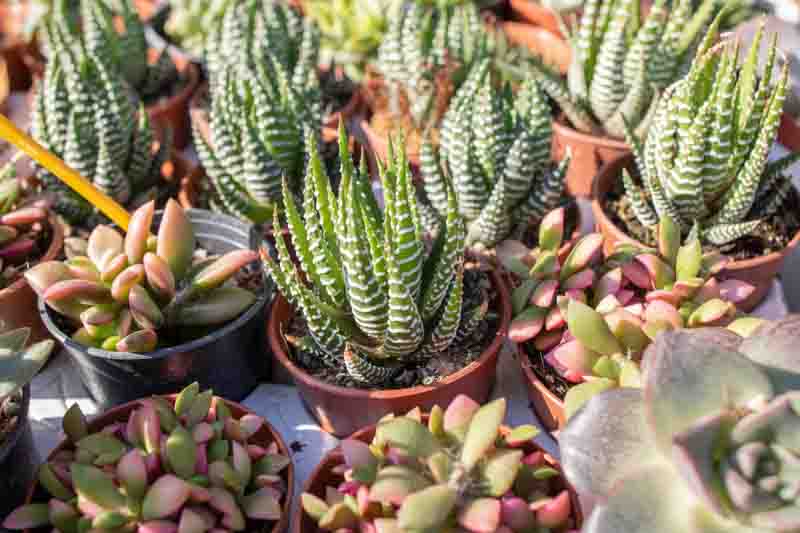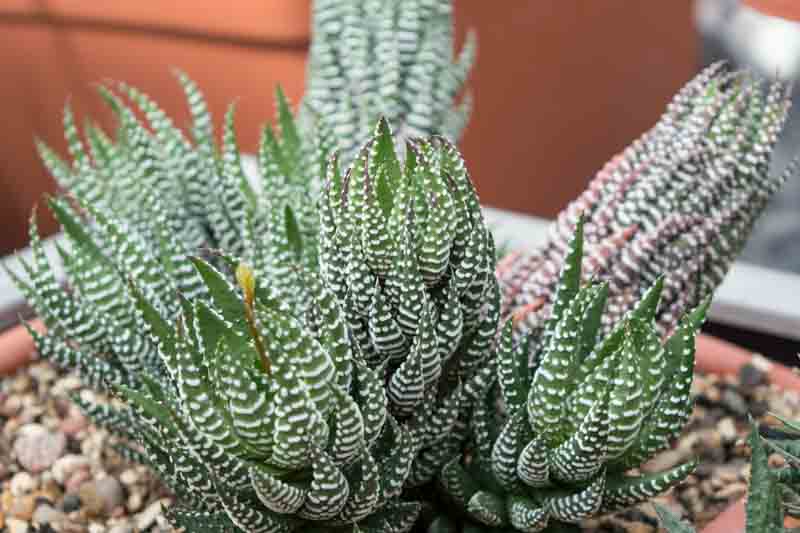Zebra Wart, Reinwardt Haworthia, Aloe reinwardtii, Catevala reinwardtii, Haworthia reinwardtii, Haworthia reinwardtii var. reinwardtii
Haworthiopsis reinwardtii, a distinctive and enchanting succulent, captures the hearts of plant enthusiasts with its striking appearance and resilient nature. This plant offers a unique blend of beauty and toughness, making it a prized addition to any succulent collection.
Haworthiopsis reinwardtii features cylindrical, dark green leaves arranged in a rosette pattern, adorned with white bumps or tubercles that add texture and contrast. These leaves spiral around the stem, creating a columnar shape distinguishing it from other succulents.
Native: This succulent is indigenous to the Eastern Cape Province of South Africa, where it thrives in rocky outcroppings and shaded nooks, demonstrating its adaptability to various light conditions and environments. Haworthiopsis reinwardtii belongs to the Asphodelaceae family along with Aloe, Eremurus (Foxtail Lily), and Hemerocallis (Daylily).
Plant Type and Habit: Haworthiopsis reinwardtii is a perennial succulent known for its slow-growing clumping habit. It proliferates by producing offsets, which cluster around the base of the parent plant, gradually forming dense, mat-like assemblies.
Size: The plant generally reaches about 4 to 8 inches (10 to 20 cm) in height, with a similar spread as it matures and produces offsets. Its moderate size makes it an ideal candidate for container gardening.
Flowers: Haworthiopsis reinwardtii blooms with slender, delicate flowers on long stems that emerge from the center of the rosette. The flowers are small, white to pale pink, and appear in the spring or early summer.
Foliage: The foliage is the main attraction, with its tubercled, spiral leaves forming a striking columnar rosette. The white bumps on the dark green leaves not only add visual interest but also help the plant retain moisture, contributing to its drought tolerance.
Hardiness: This succulent is hardy in USDA zones 9 to 11. While it can tolerate brief cold periods, it is not frost-tolerant and should be protected from temperatures below freezing.
Award: Recipient of the prestigious Award of Garden Merit of the Royal Horticultural Society.
Uses: Haworthiopsis reinwardtii is primarily used as an ornamental plant. It’s well-suited for indoor terrariums, dish gardens, and as a desk plant. Outdoors, it can be planted in rock gardens, succulent gardens, or as ground cover in suitable climates.
Toxicity: Haworthiopsis reinwardtii is generally considered non-toxic to pets and humans, making it a safe choice for households with animals.
Drought: Like most succulents, Haworthiopsis reinwardtii is highly drought-tolerant once established, requiring minimal watering.
Invasiveness: This plant is not invasive and is well-contained within its growing area, making it a responsible choice for gardens and indoor settings.
Benefits: Its water-wise nature aligns with eco-friendly gardening practices, and its ease of care makes it a fantastic plant for beginners.

Growing and caring for Haworthiopsis reinwardtii, both indoors and outdoors, requires attention to a few specific conditions to ensure its thriving growth and the maintenance of its distinctive striped leaves.
Light: Position in bright, indirect sunlight. An east or west-facing window is perfect, as direct midday sun can scorch the leaves.
Water: Allow the soil to dry completely between waterings. Water sparingly, especially in winter, to avoid root rot.
Soil: Use a well-draining cactus or succulent mix to ensure excess water can escape.
Temperature: Keep at a comfortable room temperature, between 60°F to 80°F (15°C – 27°C). Avoid exposure to cold drafts and temperatures below 50°F (10°C).
Humidity: Average home humidity levels are adequate.
Feeding: Feed with a diluted succulent fertilizer once in spring and once in summer.
Repotting: Repot every 2-3 years in spring to refresh the soil. Choose a pot just slightly larger than the current one with good drainage.
Light: Plant in a spot that receives partial shade or filtered sunlight. If the plant receives too much sunlight, it will turn a deep red, showing it is stressed, or turn white and dry up.
Soil: In garden beds, ensure the soil is well-draining. Amend with sand or gravel if necessary.
Water: Outdoor plants may require more frequent watering than indoor ones, especially in hot, dry conditions. Still, let the soil dry out between waterings.
Temperature: Haworthiopsis reinwardtii can be grown outdoors year-round in USDA zones 9 to 11. In cooler climates, it should be brought indoors before the first frost.

Propagating Haworthiopsis reinwardtii is straightforward and can be done through offsets, leaf cuttings, or seeds, with offsets being the most common and easiest method.
Wait for Offsets: Haworthiopsis reinwardtii produces small offsets or pups around the base of the mother plant. For a higher success rate, wait until these pups are a reasonable size (at least an inch wide) before separating them.
Separate Offsets: Carefully remove the soil around the base of the mother plant to expose the offsets. Using a clean, sharp knife or scissors, cut the offsets away from the parent plant, ensuring each has some roots attached.
Let Offsets Dry: Place the offsets in a warm, dry location out of direct sunlight for a few days to allow the cut surfaces to callous over. This helps prevent rot when planted.
Plant Offsets: Plant the calloused offsets in a well-draining succulent soil mix. Use small pots with drainage holes to prevent water retention.
Water Sparingly: Water the newly potted offsets lightly to encourage root growth. Wait until the soil is completely dry before watering again.
Sow Seeds: Sow Haworthiopsis reinwardtii seeds in a well-draining soil mix and lightly cover with soil. Keep moist and in a warm place with indirect light.
Germination: Seeds can take weeks to months to germinate. Keep the soil consistently moist but not waterlogged.
Regardless of the method, propagation success requires patience. Newly propagated plants may take some time to establish themselves and grow into mature, healthy plants.
Haworthiopsis reinwardtii is generally easy to care for, but like all plants, it can encounter pests, diseases, and common problems.
Mealybugs: These small, white, cottony pests tend to hide in the crevices between leaves and at the base of the plant, feeding on the sap and weakening the succulent. Treat by dabbing with a cotton swab dipped in alcohol or applying an insecticidal soap.
Root rot: This is the most common problem, usually due to overwatering or poorly draining soil. Symptoms include blackening of the base and leaves, and a mushy texture. Prevent by ensuring well-draining soil and careful watering. Affected plants should be removed from the pot, rotten roots trimmed, and repotted in fresh, dry soil.
Leaf Spot and Fungal Diseases: These can occur in overly moist conditions or when water is left on the leaves. Prevent by watering the soil directly, avoiding the leaves, and ensuring good air circulation around the plant.
Etiolation (Stretching): If Haworthiopsis reinwardtii doesn’t receive enough light, it may stretch out, losing its compact form. Provide brighter light to encourage more robust growth.
Sunburn: Direct, intense sunlight can scorch the leaves, leaving brown or white marks. Gradually acclimate plants to brighter conditions or provide filtered light.
Leaf Shriveling: Underwatering or extreme heat can cause the leaves to shrivel. Increase watering frequency slightly, but always allow the soil to dry out completely between waterings.
| Hardiness |
9 - 11 |
|---|---|
| Heat Zones |
10 - 12 |
| Climate Zones | 15, 16, 17, 20, 21, 22, 23, 24 |
| Plant Type | Houseplants, Cactus & Succulents |
| Plant Family | Asphodelaceae |
| Genus | Haworthia |
| Exposure | Full Sun, Partial Sun |
| Season of Interest |
Spring (Early, Mid, Late) Summer (Early, Mid, Late) Fall Winter |
| Height |
4" - 8" (10cm - 20cm) |
| Spread |
4" - 8" (10cm - 20cm) |
| Spacing |
4" - 8" (10cm - 20cm) |
| Maintenance | Low |
| Water Needs | Low |
| Soil Type | Loam, Sand |
| Soil pH | Neutral, Alkaline |
| Soil Drainage | Well-Drained |
| Characteristics | Showy, Evergreen, Plant of Merit |
| Tolerance | Drought |
| Garden Uses | Patio And Containers |
| Garden Styles | Gravel and Rock Garden |
| Hardiness |
9 - 11 |
|---|---|
| Heat Zones |
10 - 12 |
| Climate Zones | 15, 16, 17, 20, 21, 22, 23, 24 |
| Plant Type | Houseplants, Cactus & Succulents |
| Plant Family | Asphodelaceae |
| Genus | Haworthia |
| Exposure | Full Sun, Partial Sun |
| Season of Interest |
Spring (Early, Mid, Late) Summer (Early, Mid, Late) Fall Winter |
| Height |
4" - 8" (10cm - 20cm) |
| Spread |
4" - 8" (10cm - 20cm) |
| Spacing |
4" - 8" (10cm - 20cm) |
| Maintenance | Low |
| Water Needs | Low |
| Soil Type | Loam, Sand |
| Soil pH | Neutral, Alkaline |
| Soil Drainage | Well-Drained |
| Characteristics | Showy, Evergreen, Plant of Merit |
| Tolerance | Drought |
| Garden Uses | Patio And Containers |
| Garden Styles | Gravel and Rock Garden |
How many Haworthiopsis reinwardtii (Reinwardt Haworthia) do I need for my garden?
| Plant | Quantity | |
|---|---|---|
| Haworthiopsis reinwardtii (Reinwardt Haworthia) | N/A | Buy Plants |
Create a membership account to save your garden designs and to view them on any device.
Becoming a contributing member of Gardenia is easy and can be done in just a few minutes. If you provide us with your name, email address and the payment of a modest $25 annual membership fee, you will become a full member, enabling you to design and save up to 25 of your garden design ideas.
Join now and start creating your dream garden!
Create a membership account to save your garden designs and to view them on any device.
Becoming a contributing member of Gardenia is easy and can be done in just a few minutes. If you provide us with your name, email address and the payment of a modest $25 annual membership fee, you will become a full member, enabling you to design and save up to 25 of your garden design ideas.
Join now and start creating your dream garden!